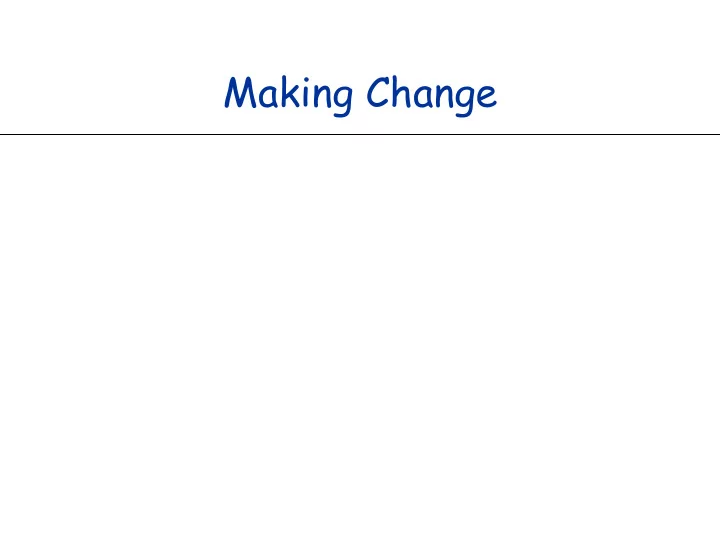

Making Change
Making Change Goal. Given currency coin denominations, e.g., {100, 25, 10, 5, 1} devise a method to pay an integer amount using the fewest coins. Example: 34¢. 25 5 1 1 1 1 Cashier's algorithm. At each iteration, add coin of the largest value that does not take us past the amount to be paid. Example: $2.89 = 289¢. 100, 100, 25, 25, 25, 10, 1, 1, 1, 1 2
Greedy Algorithm Cashier's algorithm. Use the maximal number of the largest denomination coin x – amount to be changed Sort coins denominations by value: c 1 < c 2 < … < c n . S ¬ empty coins selected while (x > 0) { let k be largest integer such that c k £ x if (k == 0) # all c k > x return "no solution found" x ¬ x - c k append(S,k) } return S Does this Greedy algorithm always work? 3
Greedy doesn’t always work 1. Greedy fails changing 30 optimally with coin set {25, 10, 1} as it produces [25,1,1,1,1,1] instead of [10,10,10] 2. Greedy fails changing 30 at all with coin set {25, 10} even though there is a solution: [10,10,10] 3. But the Greedy algorithm works for US coin set Proof: number theory (canonical coin systems) 4
Different problem: number of ways to pay Given a sorted coin set coins = {c 0 , c 1 , ..., c d-1 } c 0 the smallest coin value, and c d-1 the largest coin value, and an amount M how many different ways can M be paid? One possible recursive either / or solution: go backwards through coins and choose to use the largest remaining coin or not mkCh(n, c): # n: amount still to be paid # c: index of coins value currently considered Base: if c == 0, how many ways? (is there always a way ?) Step: if c>0 if largest coin cannot be used: consider coin c-1 else: # it can be used either use one coin c and keep considering coin c or don’t use coin c and thus consider coin c-1 5
Make change vs. knapsack Recurrence: ways(i, amount) = 1. Base case? 2. If amount < coin[i]: ways(i-1, amount) 3. Else: ways(amount-coin[i],i) + ways(amount, i-1) Making change is very similar to knapsack, but: 1. We take the sum, not the maximum, of the two options. 2. We must use the same coin value a number of times. How this is reflected in the recurrence? 6
Example of the recursive solution coins = [1,5,10,25] M = 29 use Quarters 29,3 4,3 don’t use 29,2 19,2 9,2 4,2 Dimes . . . 4,1 19,1 14,1 . . . 9,1 4,1 Nickels . . . . . . . . . Pennies 4,0 4,0 9,0 Finish this call tree
Making Change Dynamic Programming Go through the state space bottom-up: i=0 to n-1 ■ select coin type – first 1 coin type, then 1&2, ......, finally all coin types – what does the first column look like? ■ use solutions of smaller sub-problems to compute solutions of larger ones by storing previous values. Which values do you need to preserve? In the recursive solution (DC) there are 2 (recursive) sub-problems. In the dynamic programming solution there are 2 reads: don’t use current coin use current coin 0 1 2 … n-1 8
Programming Assignment 1. Write a recursive mkChange function based on the either or choices from slide 6, then turn it into a Dynamic Programming function. Do you need a 2 D table here? ■ 2. Determine the performance of the two algorithms. Later, in a written assignment, you will plot your data, and infer O complexity: Recursive: count number of calls ■ Dynamic programming: count number of table reads ■ 9
Recommend
More recommend